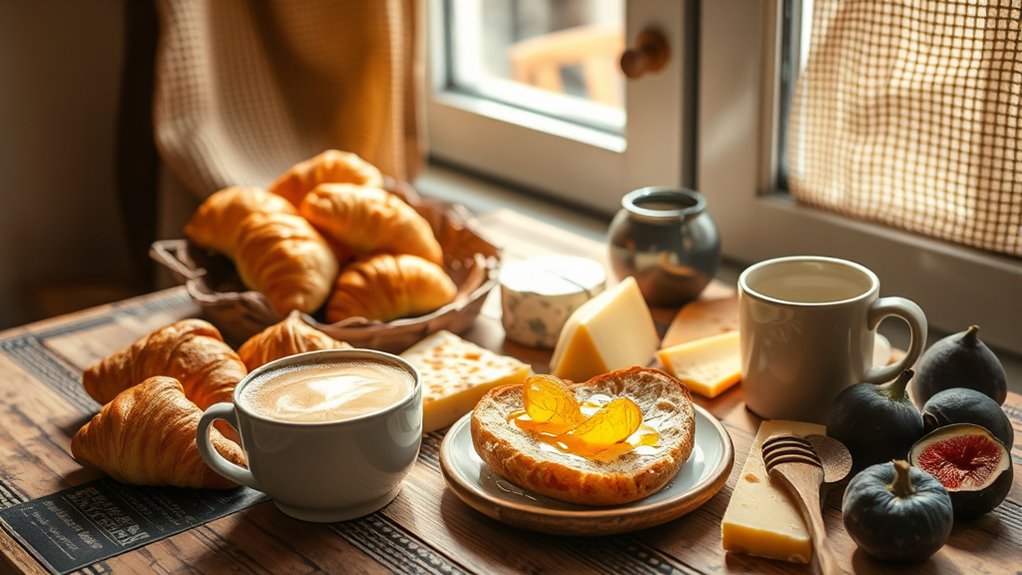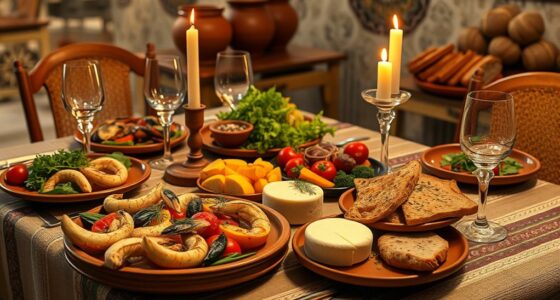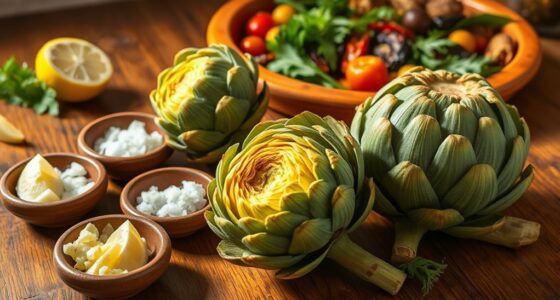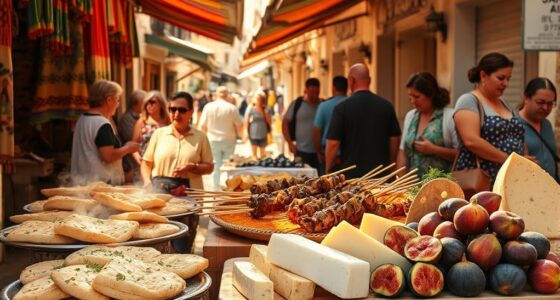Sardinian breakfast traditions focus on fresh, local ingredients like seasonal fruits, cheeses, and traditional breads baked in wood-fired ovens. Coffee plays a special role, with espresso prepared to foster social bonds at local bars. You’ll find artisanal breads such as pane carasau and hearty dairy products like pecorino cheese and yogurt often paired with honey. These meals celebrate land, sea, and craft, reflecting the island’s rich cultural identity—if you keep exploring, you’ll discover even more fascinating details.
Key Takeaways
- Sardinian breakfasts emphasize fresh, seasonal ingredients like tomatoes, fruits, and herbs, reflecting local harvest traditions.
- Dairy products such as pecorino cheese, ricotta, and yogurt are central, highlighting regional craftsmanship and nutritional benefits.
- Traditional breads like pane carasau and civraxiu, baked in wood-fired ovens, symbolize Sardinia’s artisanal baking heritage.
- Coffee culture involves high-quality espresso prepared with regional techniques, fostering social rituals and community bonding.
- The diet’s emphasis on wholesome, nutrient-rich foods supports health, longevity, and cultural identity rooted in land and sea.
The Core Components of a Sardinian Morning Meal
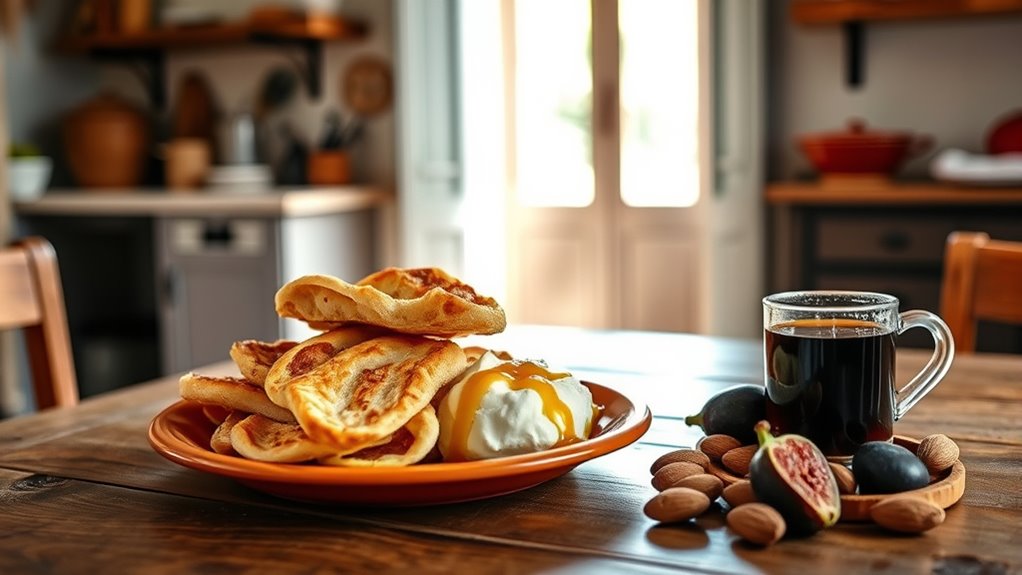
A typical Sardinian breakfast combines simple, wholesome ingredients that reflect the island’s rich culinary traditions. You’ll likely start with fresh sheep’s milk ricotta, often paired with marmalade or vegetables, offering a creamy, savory touch. Pecorino cheese, made from sheep grazing on nutrient-rich local flora, is a staple, providing a salty, flavorful component enjoyed with bread or fruit preserves. Grain-based foods like pan carasau—thin, crispy bread—and sourdough complement the cheeses, creating a satisfying yet light meal. Honey from local nectar-producing plants, especially the famous Miele Amaro from the strawberry tree, adds natural sweetness and antioxidants. Seasonal fruits and preserves balance the meal, adding vitamins and flavor. Traditional breakfast patterns in Sardinia also include coffee, which provides a caffeine boost for sustained energy throughout the day, emphasizing nutrition, digestion, and tradition, aligning with Sardinia’s focus on longevity and well-being. Incorporating nutrient-rich foods into breakfast supports overall health and complements the island’s emphasis on a balanced diet.
The Role of Espresso in Sardinian Coffee Culture

You’ll notice that Sardinian espresso isn’t just about caffeine; it’s about tradition and connection. The way baristas prepare it, with careful attention to technique, reflects the island’s artisanal pride. Sharing a quick espresso at the bar fosters friendly interactions and keeps community ties strong. Caffeine content: 60-80 mg per shot, emphasizing quality over quantity and aligning with Italy’s appreciation for flavor and craftsmanship. Additionally, the regional variations in preparation methods highlight local customs and preferences, further enriching Sardinian coffee culture.
Espresso Preparation Techniques
Espresso plays a central role in Sardinian coffee culture, serving as the foundation of the island’s traditional breakfast. You’ll find that preparing it correctly is vital for authentic flavor. Here are four key techniques:
- Use high-quality, finely ground beans—preferably from Italian roasters—to ensure rich, bold taste. Proper grind size is essential for optimal extraction, as it affects flavor and crema formation.
- Brew with a moka pot or espresso machine, maintaining water temperature between 88-93°C for ideal extraction.
- Measure 7-9 grams of coffee per shot and apply about 44 pounds of tamping pressure for even extraction.
- Aim for an extraction time of 25-30 seconds, producing a balanced, flavorful shot with a distinct crema.
Mastering these steps guarantees a robust Sardinian espresso that’s integral to your breakfast experience.
Social Coffee Rituals
In Sardinia, espresso is more than just a morning pick-me-up; it’s an essential social ritual that binds communities and fosters daily connections. You’ll find coffee bars serving as lively meeting points, where people stand at the bar to encourage brief, friendly exchanges rather than lingering. Sardinians, like Italians broadly, avoid using these spaces as workstations, emphasizing quick, meaningful interactions. Small ceramic cups and swift servings reflect the cultural value placed on efficiency and focus on social bonding. Locally produced espresso brands like La Tazza d’Oro and Karalis strengthen regional pride, reinforcing community ties. Drinking espresso mid-morning after a milky coffee is standard, with quick sips fostering conversations. Respect for the ritual’s pace and etiquette highlights its importance in maintaining Sardinian social and cultural identity. The espresso coffee tradition originated in Turin in 1884 with Angelo Moriondo’s patent of the first espresso machine, and this heritage continues to influence Sardinian coffee customs today. Additionally, the cultural significance of espresso underscores its role as a symbol of regional identity and social cohesion.
Traditional Sardinian Breads and Their Significance
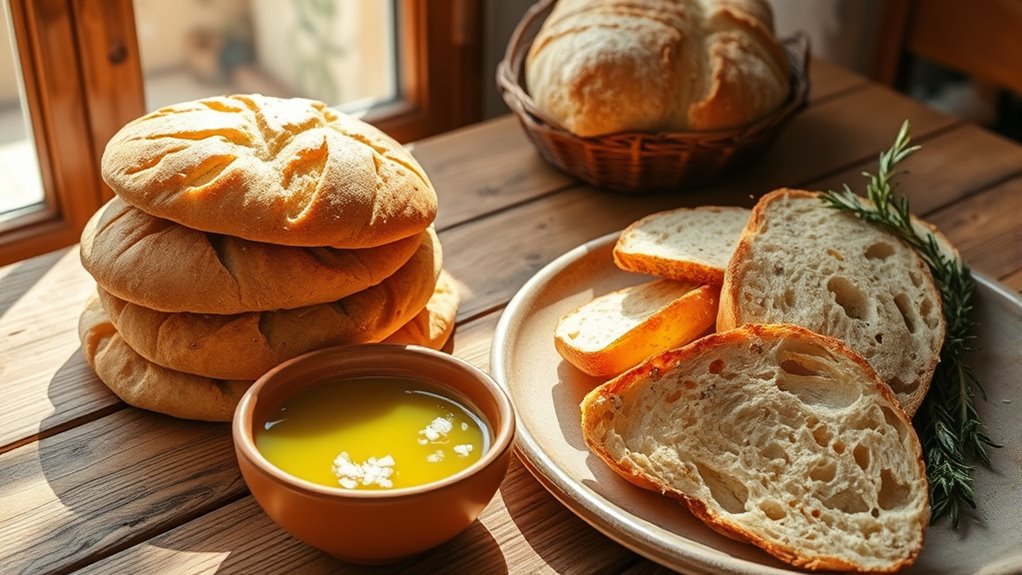
Traditional Sardinian breads play a vital role in the island’s culinary heritage, reflecting centuries of craftsmanship and local customs. You’ll find these breads not just as food, but as symbols of history and resilience. Here are four key varieties:
- Pane Carasau: Thin, crispy, baked twice for durability, perfect for dishes like pane frattau. This baking technique enhances their texture and shelf life.
- Civraxiu: Larger, soft, made with semolina and durum wheat, stays fresh for a week.
- Costedda: Small, often filled or flavored with ricotta, raisins, or pork rinds, eaten quickly.
- Su Pistoccu: Thick, hard bread from Ogliastra, lasts for months and withstands long storage.
These breads, crafted by hand and passed down generations, embody Sardinia’s pastoral roots, serving as everyday staples and cultural icons. Traditional Sardinian breads are often baked in wood-fired ovens, which contribute to their unique flavor and texture.
Dairy Delights: Cheese and Yogurt in Breakfast Traditions
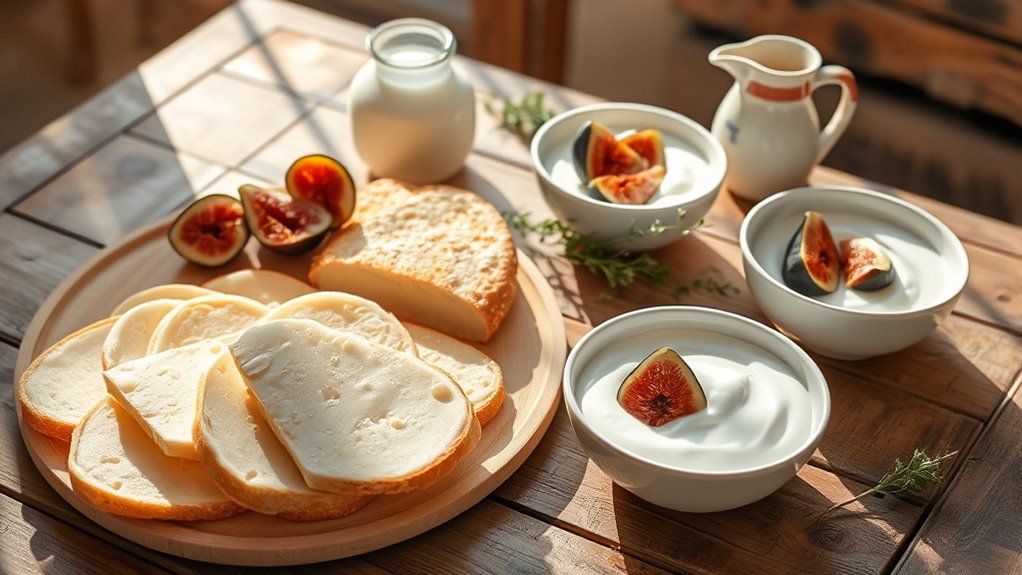
In Sardinian breakfasts, dairy products like cheese and yogurt play a central role, often sourced locally from sheep, goats, or cows. These items not only add rich flavors but also provide essential nutrients like calcium, protein, and probiotics that support your health. Whether enjoyed plain, with honey, or melted into savory dishes, dairy reflects the island’s pastoral heritage and commitment to freshness. Many traditional Sardinian cheeses, such as pecorino, are integral to breakfast and are celebrated for their unique flavors and cultural significance. The variety of dairy products available showcases the region’s local agricultural practices and dedication to traditional methods.
Types of Sardinian Dairy
Sardinian breakfast features a rich variety of dairy products that highlight local flavors and traditions. You’ll find a range of cheeses and yogurts that reflect the island’s pastoral heritage. Here are four key types:
- Pecorino Cheese – Made from sheep’s milk, aged, and eaten in small servings for protein and healthy fats.
- Ricotta – Fresh sheep’s milk ricotta, creamy and often paired with marmalade or vegetables.
- Goat Cheese – Valued for probiotics and calcium, frequently included in breakfast spreads.
- Yogurt – Thick, tangy, and made from sheep or goat milk, commonly served with honey, berries, or nuts.
These dairy delights are central to Sardinian mornings, offering both flavor and nutritional benefits rooted in tradition. Incorporating traditional dairy products into breakfast not only celebrates local cuisine but also provides essential nutrients for a healthy start to the day.
Nutritional Benefits of Cheese
Cheese offers a powerful nutritional boost to your breakfast, providing high-quality protein, essential minerals, and beneficial fats. With about 6–8 grams of protein per ounce, cheese helps keep you full and supports muscle health. It’s rich in calcium and phosphorus, crucial for strong bones and teeth, and contains vitamins A, D, K, and zinc that bolster your immune system. While cheese has significant saturated fat and sodium, choosing lower-sodium options like Swiss or goat cheese can reduce health risks. Fermented varieties supply probiotics that promote gut health. Additionally, cheese’s minimal carbs make it suitable for low-carb diets. However, moderation is key due to its calorie density and sodium content. Overall, cheese is a nutrient-dense addition that enhances breakfast by supporting bone, immune, and metabolic health. Incorporating raw dairy products can also provide additional enzymes and beneficial bacteria that support digestion and overall wellness.
Yogurt’s Role in Breakfast
Yogurt plays an essential role in Sardinian breakfast traditions, often served creamy and topped with local honey to highlight its importance as a dairy staple. It’s made from sheep, goat, or cow milk, reflecting the island’s diverse dairy sources and pastoral roots. Unlike other Italian regions, Sardinians include yogurt regularly alongside cheese and fresh milk. Its smooth texture pairs perfectly with fruits or grains, offering a light, nutritious start to your day. Here are four reasons why yogurt stands out:
- It’s rich in probiotics, supporting gut health.
- Provides indispensable nutrients like calcium, proteins, and vitamins.
- Combines naturally with honey for a sweet, probiotic boost.
- Offers a lighter alternative to heavier cheeses, balancing breakfast flavors. Dairy traditions have been preserved on the island for generations, emphasizing the cultural importance of dairy products like yogurt. Yogurt’s role is central, blending tradition with health benefits in Sardinian mornings. [Yogurt’s popularity is also linked to the island’s long-standing pastoral traditions, which have preserved dairy-based foods across generations.
Fresh Fruits and Their Place in the Sardinian Diet
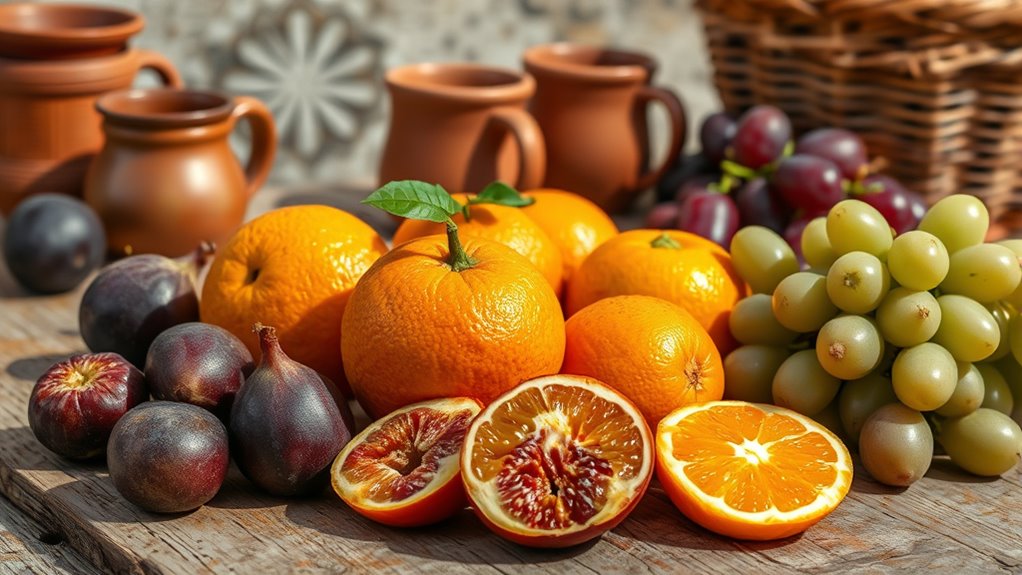
Fresh fruits hold a central place in Sardinian breakfasts, emphasizing seasonal, local produce like oranges, peaches, and melons. When you include these fruits, you enjoy peak flavor and higher nutrients, such as vitamins and antioxidants, supporting your health. Many Sardinians grow their own fruits or source them from nearby orchards, ensuring freshness and locality. Fruits serve as a natural sweetener, offering a nutritious alternative to sugary snacks. They reflect a deep-rooted tradition of seasonality and respect for nature, contributing to long, healthy lives. Consuming whole fruits or preserves helps preserve flavors beyond harvest time. Their inclusion supports immune function, digestive health, and longevity, making fresh fruit an essential, nourishing part of the Sardinian breakfast landscape. Eating seasonal produce aligns with traditional Sardinian dietary practices, promoting both sustainability and health. Incorporating local, fresh produce into meals also reduces environmental impact and supports regional agriculture.
Artisanal Baking and Natural Yeast Techniques

In Sardinian breakfast traditions, baking is more than just preparing bread—it’s a practice rooted in artisanal techniques and natural ingredients that have been passed down through generations. You’ll find that traditional methods emphasize using natural yeast, often from sourdough starters, baked in wood-fired ovens for a unique flavor. The process involves long leavening times and hand-kneading to develop texture and aroma. Here are some key aspects:
- Semolina Flour: A fundamental ingredient, mixed with other flours for authentic breads.
- Natural Yeast: Sourdough starters are maintained carefully, adding depth to the flavor.
- Water Quality: Cold water is preferred for mixing dough, especially in recipes like Su Coccoi.
- Tools and Techniques: Wooden utensils, terracotta rising pots, and traditional ovens preserve authenticity. Fermentation techniques are central to achieving the characteristic taste and texture of Sardinian breads.
Nutritional Benefits and Health Insights of Sardinian Breakfasts
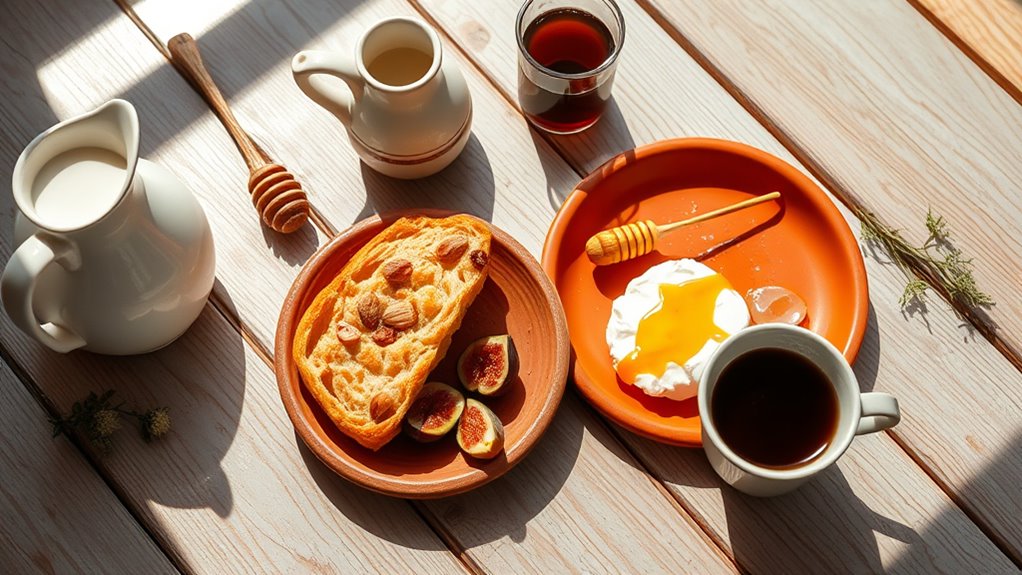
Sardinian breakfasts are renowned for their remarkable nutritional benefits, offering a balanced mix of fiber, healthy fats, and antioxidants that support overall health. The fiber from beans, vegetables, and whole grain breads promotes gut health, aids digestion, and lowers the risk of chronic diseases like heart disease and diabetes. Dairy products from sheep and goats supply omega-3 fatty acids, reducing inflammation and improving lipid profiles. Olive oil adds monounsaturated fats that support cardiovascular health. Meals are rich in nutrient-dense vegetables, wild herbs, and seasonal produce, providing antioxidants and essential vitamins. This combination ensures steady energy, stabilizes blood sugar, and reduces inflammation, contributing to longevity. Whole grains provide fiber, B vitamins, and minerals, reducing risks of heart disease, cancer, and diabetes. By prioritizing minimally processed, natural ingredients, Sardinian breakfasts foster long-term wellness and resilience.
The Cultural Importance of Shared Breakfast Rituals

1. How communal sharing strengthens social bonds.
Shared breakfast rituals serve as a daily reminder of community and kinship, fostering a sense of belonging and mutual support among Sardinians.
2. The symbolism behind wheat for health and fertility.
The tradition of Is Candeberis, where wheat is exchanged and shared, embodies hopes for health and fertility, reinforcing the belief that abundance begins with nourishment.
3. Family traditions passed through generations.
Many Sardinian families continue to prepare and enjoy traditional breakfast foods, preserving cultural practices and stories that connect past and present generations.
4. The role of breakfast in preserving Sardinian heritage.
These rituals and recipes act as living symbols of Sardinian identity, ensuring that cultural heritage remains vibrant and relevant in contemporary life.
How Local and Seasonal Ingredients Shape Sardinian Mornings
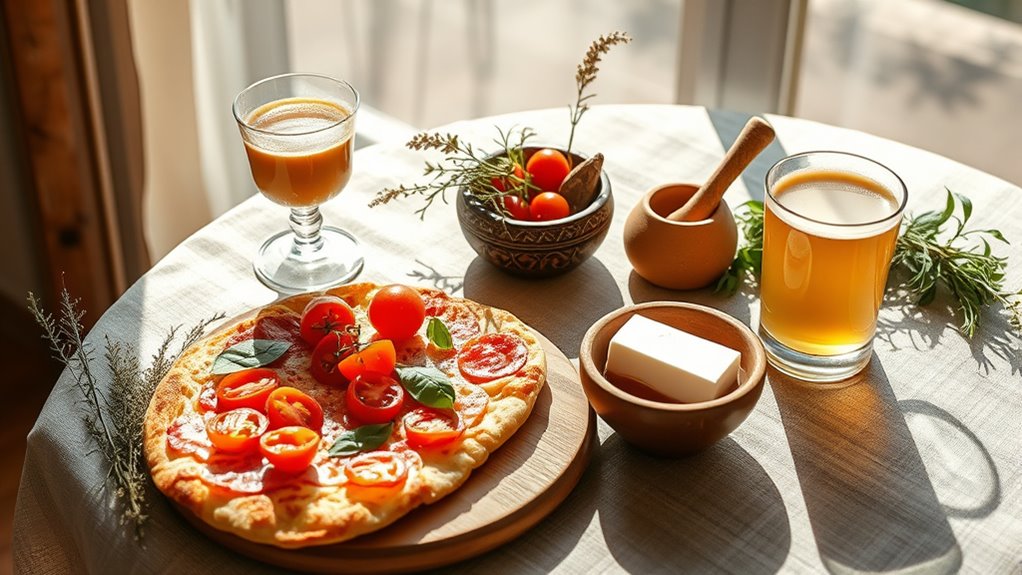
Local and seasonal ingredients deeply influence Sardinian breakfast traditions, shaping what families prepare each morning. You’ll find Pane Carasau, the paper-thin, crispy bread, often rehydrated with warm stock before serving. Its ingredients come from locally grown wheat, reflecting seasonal harvest cycles. Fresh, ripe tomatoes are used for sauce, flavored with herbs from nearby gardens, tying breakfast to the island’s harvest rhythm. Sardinians also enjoy pecorino cheese, made from sheep’s milk, which varies in flavor with grazing seasons. Olives and their cold-pressed oil add seasonal richness, while legumes and whole grains provide essential nutrients, often prepared using local harvests. These ingredients, sourced from the land and sea, create a breakfast rooted in freshness, tradition, and the natural cycle of Sardinia.
Frequently Asked Questions
How Has Sardinian Breakfast Tradition Evolved Over Centuries?
You’ve asked how Sardinian breakfast traditions have evolved over centuries. You’ll see that they started with Roman foods like bread, cheese, and honey, then absorbed influences from Arab and medieval cultures, adding ingredients like rice and citrus. Today, traditions remain rooted in simple, high-quality ingredients like bread, cheese, and honey, honoring the past while adapting to modern tastes. The focus on natural, local foods continues to define Sardinian breakfasts.
What Are Regional Differences in Sardinian Breakfast Foods?
You’ll notice that regional differences shape Sardinian breakfast foods, with coastal areas favoring seafood and fresh produce, while inland regions prefer hearty bread and cured meats. In the mountains, shepherd-inspired dishes like Pane Frattau are common, showcasing local ingredients like pecorino cheese and durum wheat. These variations reflect local climate, history, and available ingredients, giving each area its unique breakfast touch that highlights Sardinia’s diverse culinary heritage.
Are There Specific Rituals Associated With Sardinian Breakfast?
You’ll find that breakfast in Sardinia isn’t just about food; it’s rich with rituals. You might start your day with a strong espresso, symbolizing a fresh beginning, or share trigu on New Year’s Day, representing prosperity. Visiting neighbors for homemade bread or trigu, exchanging greetings like “salude e trigu,” strengthens community bonds. These practices celebrate tradition, health, and unity, making breakfast a meaningful, communal experience.
How Do Sardinian Breakfast Practices Vary Between Urban and Rural Areas?
Imagine a morning where your surroundings shape your breakfast, whether bustling or serene. In cities, you’ll grab quick, diverse options like pastries or modern café drinks, fitting your busy life. In rural areas, you’ll enjoy simple, traditional fare like homemade bread, cheese, or honey, often shared with family. Your environment influences your choices, blending convenience with culture, creating unique breakfast routines that reflect your lifestyle and community.
What Influence Has Tourism Had on Traditional Sardinian Breakfast?
Tourism has profoundly influenced Sardinian breakfasts by introducing international items like pastries and fruit juices alongside traditional espresso and bread. You’ll notice more diverse grains, elaborate dishes, and packaged dairy replacing fresh local products. While this attracts visitors, it also risks diluting authentic practices. To preserve the heritage, some locals emphasize artisanal sourcing and cultural education, ensuring your experience remains genuine and connected to Sardinia’s rich culinary traditions.
Conclusion
So, next time you start your day, remember that Sardinians prove breakfast isn’t just a meal—it’s a celebration of tradition, simplicity, and local flavors. Who knew that a humble bread, a shot of espresso, and fresh cheese could hold centuries of culture? Maybe it’s time to rethink your morning routine—after all, why settle for cereal when you could be embracing a centuries-old ritual that’s practically a love letter to food?
